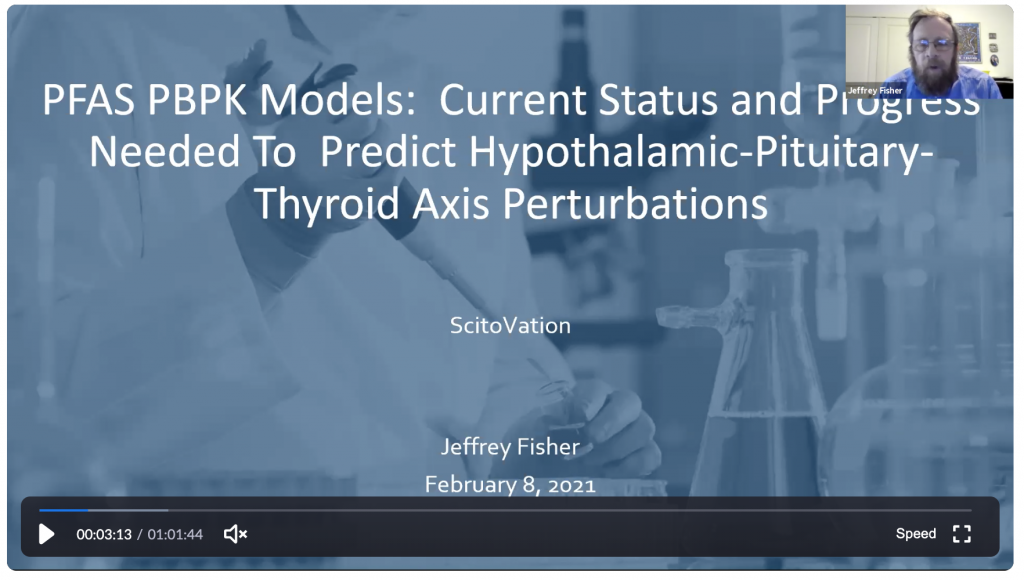Webinar
PFAS PBPK Models: Current Status and Progress Needed To Predict Hypothalamic-Pituitary-Thyroid Axis Perturbations
When: Feb. 8, 12pm EST
Medium: Zoom Webinar
Presenter: Dr. Jeffrey Fisher
Title: PFAS PBPK Models: Current Status and Progress Needed To Predict Hypothalamic-Pituitary-Thyroid Axis Perturbations
Please join us on Monday, Feb. 8, for a special educational webinar presented by Dr. Jeffrey Fisher, Senior Science Fellow for the Computational Biology Division of ScitoVation.
Thanks to all who attended, making this webinar a huge success! If you missed it, you may access a recording of the event below.

Abstract
PFAS PBPK Models: Current Status and Progress Needed To Predict Hypothalamic-Pituitary-Thyroid Axis Perturbations
To date, there are no published biologically based dose response models for the hypothalamic pituitary-thyroid axis for Per- and Polyfluoroalkyl Substances (PFAS). There are PBPK models for PFAS in laboratory animals and humans. Using computational methods important epidemiologic interpretations for PFOA and PFOS internal exposure have been conducted by scientists from Hamner/ScitoVation and Ramboll, including a serum TSH evaluation. Several laboratory animal studies report hypothyroxinemia (low serum thyroid hormones and normal serum TSH levels). I proposed a MOA for hypothyroxinemia that involves upregulation of deiodinase II in the hypothalamus based on results found from many studies involving cold (thermogenesis), fasting, and infections. This presentation is adapted from a webinar given to the Federal Information Exchange in December, 2020.
Dr. Jeffrey Fisher
Dr. Jeffrey Fisher is a Senior Science Fellow for the Computational Biology Division of ScitoVation. He was a Research Toxicologist with the U.S. Food and Drug Administration, National Center for Toxicological Research (2010-2020). He was formerly a Professor in the Department of Environmental Health Science, College of Public Health at the University of Georgia (UGA). He joined the University of Georgia in 2000 and served as Department Head of the Department of Environmental Health Sciences from 2000 to 2006 and Director of the Interdisciplinary Toxicology Program at UGA from 2006-2010. From 1975 to 2000 he worked at a toxicology laboratory, Wright Patterson AFB. He started working as a technician, then progressed to principal investigator and senior scientist in the Toxics Hazards Division before becoming the Technical Advisor for the Operational Toxicology Branch.
Dr. Fisher’s research interests are in the development and application of pharmacokinetic and biologically based mathematical models to ascertain health risks from environmental, food-borne and occupational chemical exposures. While in the FDA he has become involved in the use of PBPK models for drug dose selection in pediatric populations. Dr. Fisher’s chemical toxicology modeling experience includes working with chlorinated and non-chlorinated solvents, fuels, pesticides, perchlorate, PFOA, and bisphenol A. He has developed PBPK models for use in cancer risk assessment, estimating lactational transfer of solvents, understanding in utero and neonatal dosimetry, quantifying metabolism of solvent mixtures and developing biologically motivated models for the hypothalamic-pituitary-thyroid axis in rodents and humans. Dr. Fisher has 30 years of experience in physiological modeling and has trained several graduate students and postdoctoral fellows on the concepts and application of physiological models. He was a visiting scientist at the Chemical Industry Institute of Toxicology in 1996 and at the NIOSH Taft Laboratory in 1999. During this time, he also served as Adjunct Professor in the Department of Pharmacology and Toxicology at Wright State University. Dr. Fisher has published over 190 papers on pharmacokinetics and PBPK modeling in laboratory animals and humans. He has served on several national panels and advisory boards for the DoD, ATSDR, USEPA and non-profit organizations. He was a U.S. delegate for the North Atlantic Treaty Organization. He was president of the Biological Modeling Specialty Section of the Society of Toxicology (2019), member of the National Academy of Sciences subcommittee on Acute Exposure Guideline Levels (AEGLs) from 2004-2010 and a member of the Science Advisory Board (SAB) for the US EPA (2007-2010). He has served recently as an ad hoc member of the SABs for dioxin and perchlorate. He is a fellow of the Academy of Toxicological Sciences and a former associate editor for Toxicological Sciences. Dr. Fisher has a B.S. degree in biology from the University of Nebraska at Kearney, a M.S. degree in biology from Wright State University, and a Ph.D. in zoology/toxicology from Miami University.
